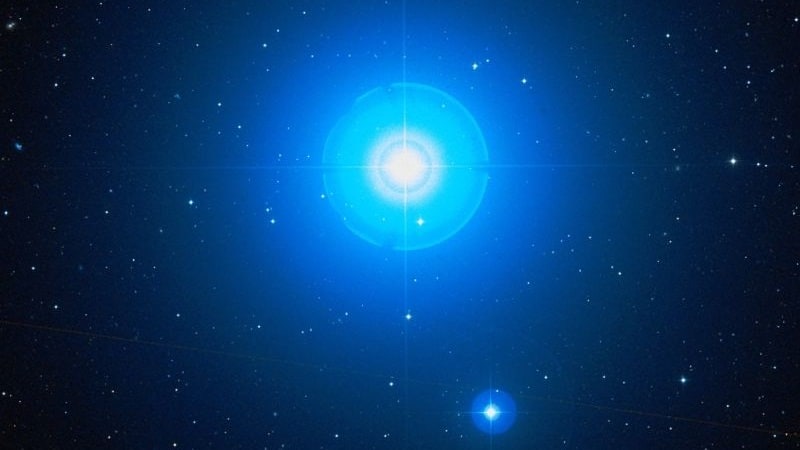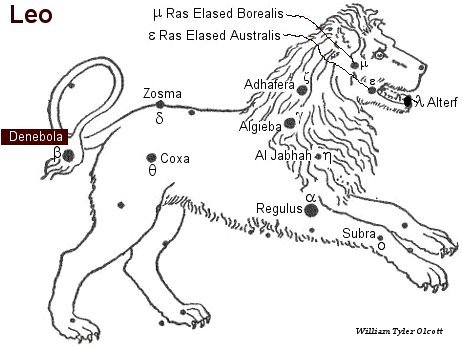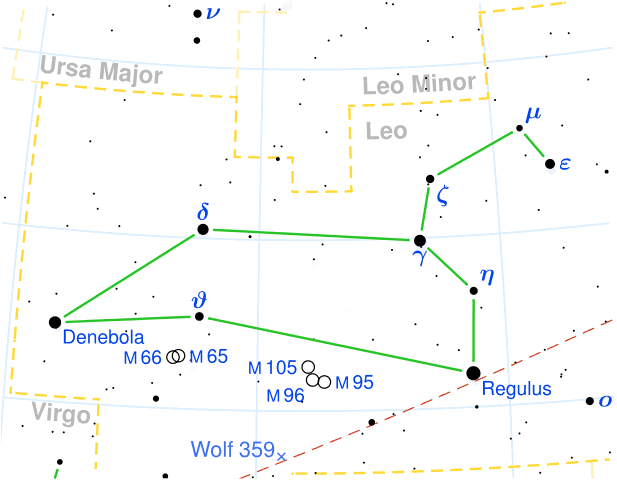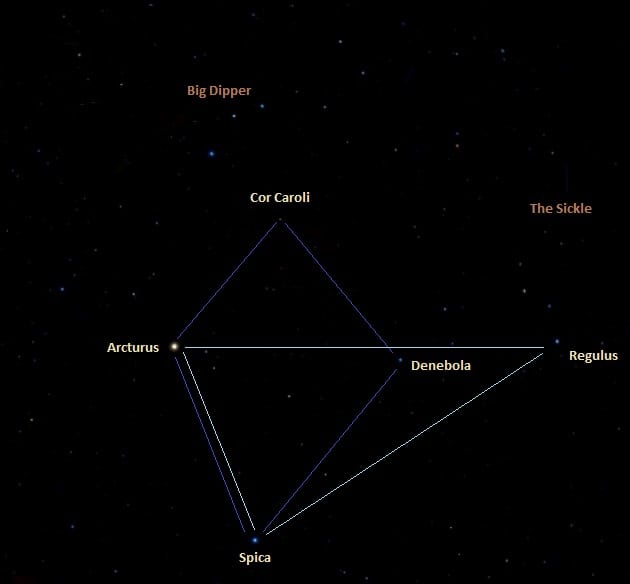Denebola, or Beta Leonis, is the second brightest star in the zodiacal constellation of Leo, and the 59th brightest star in the night sky. It can be seen with the naked eye and it is a variable star.
Key Facts & Summary
- Denebola appears bluish-white, and it is located at around 35.9 light-years / 11.00 parsecs away from the Sun.
- Denebola is a main-sequence star of spectral type A3Va, since it varies in luminosity.
- It is suspected that it belongs to the Delta Scuti type of variable stars, as its luminosity varies very slightly over a period of a few hours.
- Denebola has an apparent magnitude of 2.113 and an absolute magnitude of +1.93.
- It is around 75% more massive than our Sun, having 1.78 solar masses.
- Denebola has a radius of around 1.728 that of the sun, and surface gravity of 4.0 cgs.
- The star has an oblate shape with an equatorial bulge due to its high rotational velocity.
- The rotational velocity of Denebola has been estimated to be at around 128 km / 79.5 mi per second.
- It is quite a young star, at an estimated age of around 100 to 380 million years.
- Denebola is 15 times brighter than our sun and has average surface temperatures of around 8.500 K.
- Along with Spica and Arcturus, Denebola is part of the Spring Triangle asterism, and by extension, also of the Great Diamond together with the star Cor Caroli.
- Denebola is enveloped by a circumstellar debris disk of cool dust. Temperatures here are around 120 K / -153 degrees C.
- This disk is at around 39 AU away from Denebola. This suggests that the star may be a candidate for extrasolar planets since the solar system also formed from out of such a disk.
- Studies have shown that Denebola is part of the stellar association IC 2391 supercluster.
Since Denebola marks the celestial Lion’s tail, the ancients named it as such. Denebola is shortened from “Deneb Alased”, it is of Arabic origin and roughly translates to the “tail of the lion.”

Many stars such as Deneb of the Cygnus constellation, are named Deneb, or something very similar since they mark the tails of their celestial animal constellation.
Formation
Denebola is believed to have formed less than 400 million years ago, between 100 to 380 million years. Since kinematic studies have proved that Denebola is part of the stellar association IC 2391 supercluster located in the constellation of Vela, a group of stars with similar age and motion through space, it is suggested that it was born in the same location as them. The star is much younger than our sun.
Distance, Size, and Mass
Denebola is located at around 35.9 light-years / 11.00 parsecs away from the Sun. is the second brightest star in the zodiacal constellation of Leo, and the 59th brightest star in the night sky.

Denebola is around 75% more massive than our Sun, having 1.78 solar masses. It has a radius of around 1.728 solar radii, or almost 173% sun’s radius. Thus, it is perhaps more than twice the size of our sun.
Other Characteristics
Denebola is a main-sequence star of spectral type A3Va, it is a particularly luminous dwarf generating energy through nuclear fusion at its core.
It has an apparent magnitude of 2.113 and an absolute magnitude of +1.93. It is also a suspected Delta Scuti variable star. It exhibits variations in its brightness 0.025 magnitudes roughly ten times per day.
Denebola is 15 times brighter than our sun, and hotter, having estimated surface temperatures of around 8.500 K. Thus, it is around 1.4 times hotter than our sun.

The star shows a strong infrared excess, showing a circumstellar debris disk of cool dust in orbit around it. This dust has a temperature of about 120 K / -153 degrees C. It is 39 AU away from the star and studies suggest that because of this feature, the star is a likely candidate for having extrasolar planets around it, or that may take shape.
Vega and Beta Pictoris also display such a feature, and it is believed that through such a stellar disk, our own solar system may have formed out of.
The star has a surface gravity of 4.0 cgs, and it appears to have an oblate shape with an equatorial bulge. This is most likely due to its high rotational velocity that was measured to be around 128 km / 79.5 mi per second.

Location
Denebola is located in the zodiacal constellation of Leo, the celestial lion. Together with the stars Spica and Arcturus, Denebola forms a prominent asterism known as the Spring Triangle. This asterism appears in the evening sky from March to May.

By extension, Denebola is also part of the Great Diamond together with the star Cor Caroli and Spica.

The Future
Denebola is quite a young star, and since it is enveloped by stellar disk similar to the one theorized to have been the progenitor of our own solar system, the star will most likely remain a strong candidate for extrasolar planets and thus continue observations will not cease so likely.
Did you know?
- Another star that seems to spin relatively similar to Denebola, is Achernar, the brightest star in the constellation of Eridanus.
- Other stars that are associated with the IC 2391 supercluster, are the Alpha Pictoris, in the constellation of Pictor, and Beta Canis Minoris, in the constellation of Canis Minor.
- In astrology, Denebola was believed to portend misfortune and disgrace.
- In the Alphonsine Tables, Denebola was recorded as Denebalezeth, while on R.A. Proctor’s 1871 star chart, Denebola was designated as Deneb Aleet.
- The 15th century astronomer Timurid Sultan Ulugh Beg, gave Denebola, the “Changer (of the weather)” individual title.
- One of the Muslim scholars of the 11th century noted that the heat faded once the star rose, and the cold turns away when it disappears.
- The ancient Chinese astronomers designated Denebola as the first star of the five-star asterism “Seat of the Five Emperors.”
- In Hindu astronomy, Denebola was associated with Nakshatra – one of the 28 sectors along the ecliptic, named Utarra Phalguni – second reddish one.
Sources:
Image source:
- https://www.liberaldictionary.com/wp-content/uploads/2019/02/denebola-5725.jpg
- https://encrypted-tbn0.gstatic.com/images?q=tbn:ANd9GcQ3A7WYAq5GlHshWAeW11m6hhIM-hETE2cPsXJ_B-AQWjyRC1RW&s
- https://lh5.googleusercontent.com/proxy/btdpQiyPKHZn8P_YHC2zskyQoSZpZvs8wc3ztXAwaIaSCrywpVD6YuZnGXi-FdDvFp0unYAEnjCr4WDhYA
- https://www.constellationsofwords.com/images/stars/denebola.JPG
- https://upload.wikimedia.org/wikipedia/commons/thumb/7/71/Leo_constellation_map.svg/617px-Leo_constellation_map.svg.png
- https://www.star-facts.com/wp-content/uploads/2019/09/Spring-Triangle-and-Great-Diamond.jpg?189db0&189db0
